


If you’re like 85% of small business owners in North America, you rely on word-of-mouth referrals to build your chiropractic business.
But did you know that 99% of consumers searched online to find information about a local business in the last year? Or that the top three organic search results attract 68.7% of all clicks? Or that only 0.63% of searchers actually click on links from the second page of results?
Bottom line: Referrals are great for business, but if you’re not ranking for localized search terms on page #1 of search engines, you’re losing out to competitors who are.
So, what’s a chiropractor like you to do about it?
In this post, we’ll divulge nine ways to improve your local SEO and put your practice in a position of prominence—and on the map (so to speak). But before we dive in, you should understand exactly where you’re aiming to place your web properties, such as a website, within the results.
When ranking organically, there are two distinct sections on Google’s first page of results where your practice can appear.
The first is in Google’s “Local Pack” (a.k.a. Map Pack, Snack Pack, or 3-Pack), as seen below:
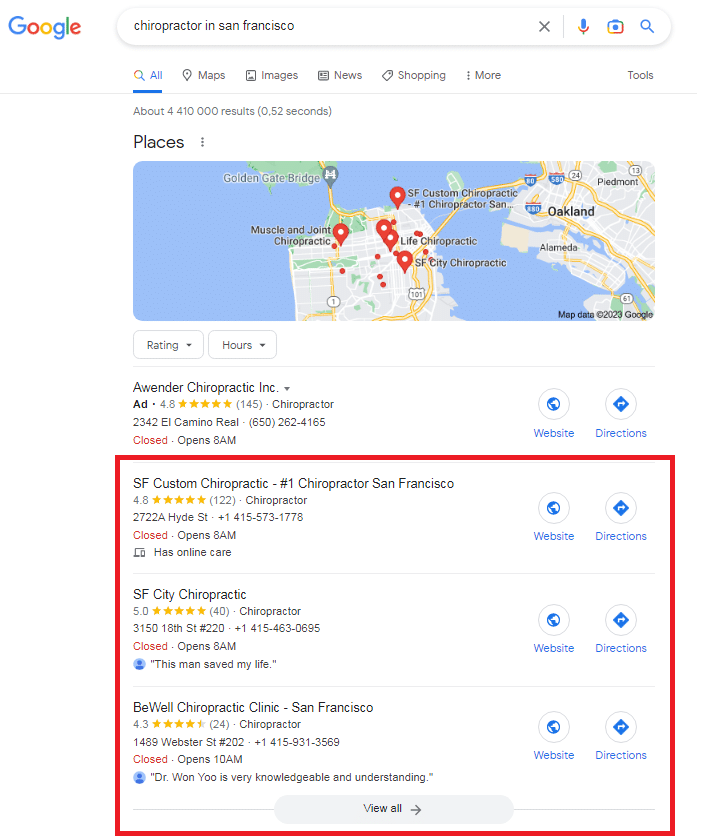
This section displays the three most relevant organic listings for local businesses related to a specific search query with local intent. The Local Pack can also include a paid ad that appears above the three organic results and is labeled as such.
The second place is in organic results. This is the section of the results page that contains listings that most closely match the search query based on relevance, as per our example below.
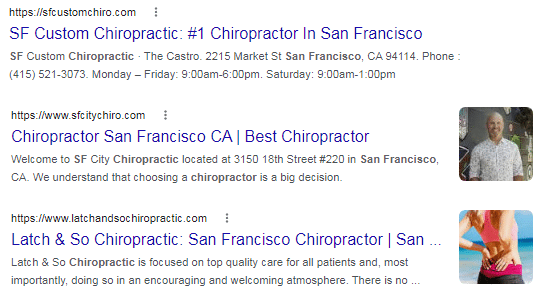
Now that you know where you’re trying to get your web pages to place, the question becomes: which variables do search algorithms factor into localized organic rankings?
SEO experts have been debating ranking factors for decades, with the most comprehensive list containing over 200+ SEO factors. Believe it or not, former Google employee Matt Cutts, confirmed that there could be up to 50 sub-signals or variations for each of those factors, making SEO a far more complex beast than most people realize.
However, when we refer to local search ranking factors, we’re talking about variables experts have identified as having a demonstrable or theoretical impact on the rankings of local businesses like chiropractic offices.
In 2018, Moz published findings from a Local Search Ranking Factors Study that indicates how the most important factors are categorized and prioritized for both Google’s Local Pack and localized organic search results. Here’s that breakdown:
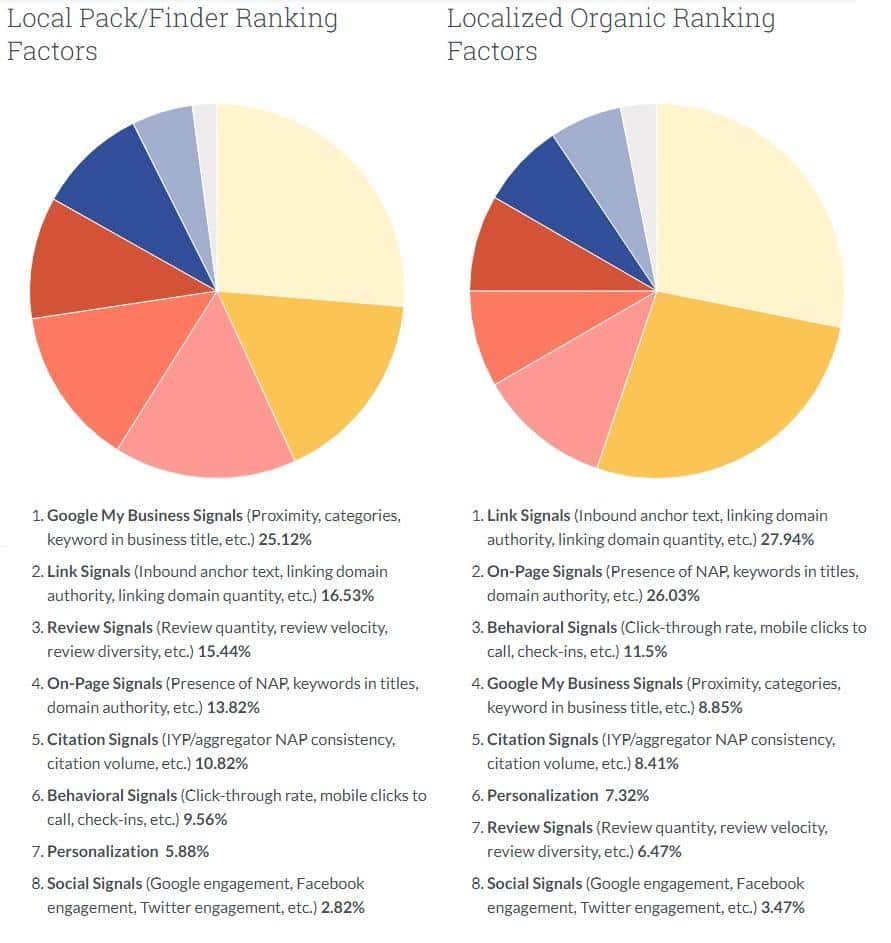
(Source: Moz)
While additional studies weigh the importance of these factors differently, they all contain the same or similar categories. So, let’s take a brief look at each.
With these factors in mind, let’s explore how you can leverage SEO tactics to boost your practice’s search visibility.
It may sound cliché, but content always has been and always will be king. It’s the lifeblood of everything you do online, which is why consistently publishing high-quality content liberally sprinkled with search terms your target audience is already searching for is fundamental to your success.
Keep in mind that at the heart of content are your keywords. Your prospective patients are looking for answers to why they have back pain, how they can alleviate neck pain, how to heal sports injuries naturally, and more. They’re using search terms related to these topics, so it’s understandable search algorithms will only deliver results that match what users want.
To stay ahead of the game and at the top of search results, you need content that’s created based on search intent, provides value and is optimized to beat out competing sites. If you’re not sure what that entails, check out our in-depth post on how to create content that ranks well, woos readers, and generates leads. You’ll be a pro in no time.
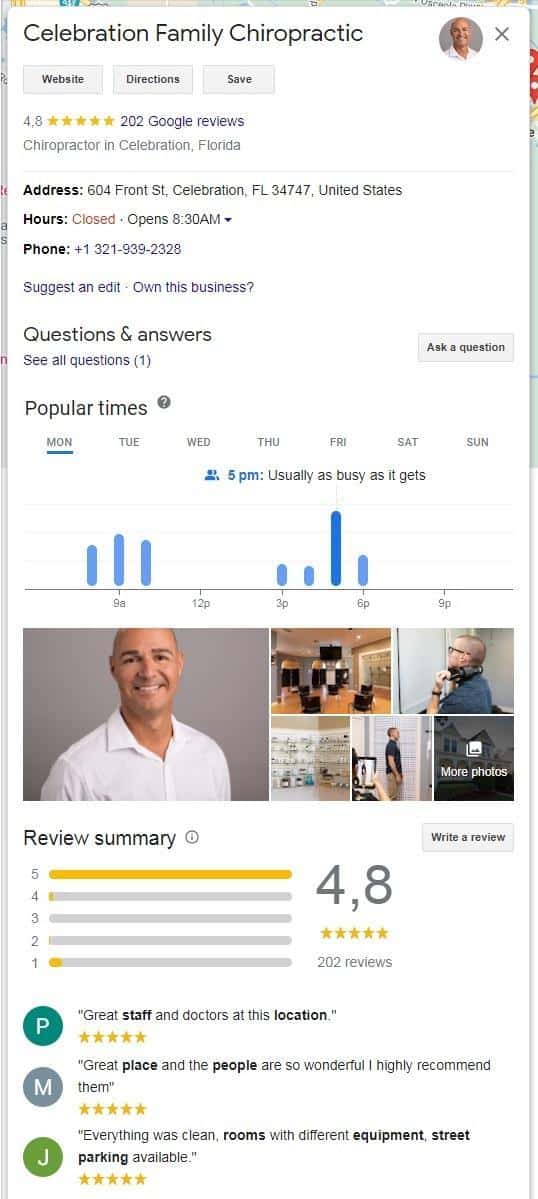
GMB is a fantastic free tool that helps amplify your exposure while creating a presence for your practice across all of Google. Since it’s a Google-owned product, the search giant naturally prioritizes GMB listings in search results, which is why it’s so important to include it in any location-based SEO strategy for chiropractors.
If you haven’t already claimed your listing, sign up for Google My Business now.
To get set up and optimize your GMB account correctly so that your listing has a better chance of ranking in the top three Local Pack results, check out our previous posts here, here, and here for complete tutorials and tips for creating an unbeatable profile.
It’s crucial to note that GMB ranks listings based on three key factors:
If you already have a GMB profile, here’s our list of quick-fire optimization tips to ensure your listing is page #1 perfect:
On a final note, be sure to claim and optimize your business listings on Apple Maps and Bing Places for Business as well. This will help maximize your traffic sources and generate more patient inquiries outside of Google search results.
Citations are critical to attaining visibility in local search results. In fact, research by BrightLocal reveals that local businesses ranked in the top 10 spots have at least 81 citations.
However, you need to ensure existing citations are consistent and accurate before you start growing your citation profile. You can do this by manually conducting a local citation audit and clean-up or by using free tools like Moz Local. You can also outsource the work to SEO freelancers or use paid solutions like The HOTH or WhiteSpark.
Here’s what a good NAP citation looks like.
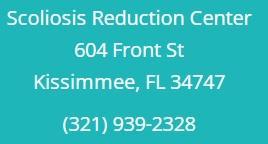
Once your existing citations are consistent and accurate across all platforms, you should focus on identifying opportunities for new citations to strengthen your geo-location search presence.
You can create new citations in four different ways:
You can also use tools like BrightLocal’s top local citation sites by business category, Omnicore’s 200+ local SEO citation sources, and Whitespark’s top 50 citation sources in the U.S. to search for additional citation sources. More citations result in more exposure, so create as many as you can.
In our post on optimizing blog content, we explained how to ensure your content ranks well by strategically placing keywords in your page title, Meta description, sub-heads, permalink, anchor text, image alt text, image descriptions, and more. While it’s an excellent start, there are other site-wide on-page SEO techniques you can use to help boost rankings.
You should also perform an SEO site audit using tools like SEO Analyzer, Ahrefs Site Audit, or WebFX’s SEO Checker. These tools will analyze and grade your website’s ability to appear in search results, providing insight into areas that need work. If these on-page SEO concepts are new to you, consider hiring an SEO pro to assist you.
Algorithms use links as a vehicle for finding new websites and pages online. They also use links to assess a site’s credibility, which makes developing a solid link strategy critical to your success.
How can you build a massive backlink profile?
Building a massive backlink profile will take time, but it can pay off massively in search results. Make sure you’re regularly looking for opportunities to help in your efforts so that you can improve your rankings faster.
Reviews not only affect local search rankings but also impact your reputation and credibility. And more often than not, they’re the deciding factor for prospective patients.
Since reviews can either make or break your positioning in search result pages, let’s take a quick look at how they’re measured by Google’s algorithm.
Google considers four main factors when considering reviews:
A chiropractor with lots of helpful, genuine reviews that are posted regularly and frequently is likely to rank higher than a chiropractor with few poor-quality reviews that were posted two years ago and don’t say much.
Although you cannot control every aspect of ratings and reviews, you can encourage a culture of reviewing within your practice. For example, check in with patients and ask them to leave a review if they mention that they’re happy with your care, add a review request email to a follow-up sequence, and create a social media post asking past patients to let others know about how you helped them.
In addition, you can set up processes and systems to make generating reviews easy.
Here are some basic steps to follow:
Step 1: Claim and optimize your profiles on review sites like Yelp, Facebook, Google My Business, and other review platforms and sites that your chiropractic patients might frequent.
Step 2: Be proactive in creating an optimal patient experience by training employees on customer service, implementing quality control measures, and practicing proper review management. Happy clients write positive reviews.
Step 3: Provide multiple opportunities for patient feedback so that you’re catching any grievances before they turn into negative reviews. Conduct face-to-face check-ins with patients and monitor social media for mentions of your practice.
Step 4: Make responding to reviews—good or bad—a priority. This lets patients know that you’re listening to them, which makes them feel valued.
Ultimately, reviews have the power to affect your rankings, reputation, and revenue. Although you can’t govern what people say, you can systemize your approach so that you’re consistently and ethically harvesting positive reviews from a satisfied patient base.
A while ago, we published a post on rocking your local inbound strategy with social media. In it, we explained in detail how to optimize your social profiles for search, engagement, and lead generation. However, you’ll also want to make sure you’re taking steps to improve your SEO.
Even though social media won’t directly increase your rankings, we know that there’s a strong correlation between ranking position and social signals. In addition, we know that search algorithms like Google are always trying to understand the authenticity, expertise, and authority of a creator or author. Therefore, social media signals can be an indicator of relevance and quality.
So, what can you do to aid in boosting your social signals?
Social is assuming a bigger role in local marketing, so it’s vital to factor it into your local SEO strategy. The reality is that chiropractors with a greater presence on these platforms tend to rank higher than those without one, so get more social today.
User experience is becoming increasingly important for SEO, as every action a user takes on your website and external online assets sends a signal to Google. If your content doesn’t meet a specific search query, it’s unlikely the searcher will interact with it. Therefore, you need to incentivize users to click, engage, and convert. Thankfully, this entire post has been priming you for success by helping you create the optimal user experience.
Let’s recap:
Ultimately, interpreting user experience is the key to boosting behavioral signals. A great experience equals great results.
As we mentioned, you don’t have much control here since Google applies personal usage data to surface search results relevant to the individual searcher. However, there are four key things you can do to help your efforts.
Google is always learning more about its users in an effort to display relevant results. What one person sees in SERPs may be different from what another person sees, so make your content and site as relevant as possible if you hope to influence personalization factors.
We hope this post has not only helped you understand why chiropractic SEO should be your #1 priority for growing your business in 2023 and beyond but also identify areas of SEO optimization that need work.
So, what can you do right now to level up your SEO game as a chiropractor?
If you’re feeling overwhelmed, develop an action plan that has you working on at least one aspect of your SEO for just a few hours every month. And if you need help accelerating your efforts, reach out to our team to chat about how we can help put you on page #1.
And if you’re wondering whether we’ve got the SEO chops, check out our case study on how we ranked 3,748 keywords on page #1 of Google and increased conversions by more than 71% for just one of our chiropractic clients.
